|
|
8 x 60 Carl Zeiss Deck Mounted, production No. 1689712
The binocular was manufactured in February 1936. It has got an imperial eagle. The model 8 x 60 Porro II was produced in several versions since, approximately 1920. This model was mainly designed for the Navy for search and following aircraft at night. Our model it is a navy binoculars with the letter ‘M’. The binocular was built up, by Carl Zeiss Jena, after 1935 as the shape of the eagle indicates. The model is name as ‘Deck Mounted’, by the collectors. It is very heavy binocular. The weight is – 7.2 kg.
Read more on the article
|
|
|
|
|
|
|
|
|
|
8 x 60 Carl Zeiss Deck Mounted, production No. 1787295
The binocular was produced in August 1937.
|
|
|
|
|
|
|
|
|
|
8 x 60 Carl Zeiss Deck Mounted, early model
The 8x60 is a distinct night glass, designed primarily for searching and tracking of aircraft. Because of its heavy weight, it is no suitable for use in the hand only on a tripod.
It was used in particular, for directional devices for the nightly aircraft defenses, for example, in cooperation with listening devices detect an air target and then provide as a guide for headlights, predictors, etc.
The binocular was produced in 1919. It was first type Porro II 8 x 60 model.
This particular glass returned to the Zeiss factory before the WWII and the optic was fully coated, which the large “T” mark signifies. The binoculars received the eagle, swastika symbol and the “M” mark as well.
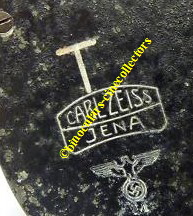
It is visible that the coating was applied before 1940 as the early coating does not go completely to the edge of the objectives.
The reticule has a cross in the center, and surrounding with a large circle.
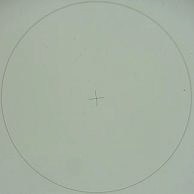
The binocular has a dovetail fitting to attach the lamp to illuminate the reticule, as the model described above.
As an accessory to the binocular was a night lighting: lamp house with mechanical and lamp brightness control run on a cable from a battery box.
The eyepiece on this binocular is of the first type; later deck mounted at 8 x 60 had two or three more types of eyepieces.
The diameter of eye lens is - 22 mm. The exit pupil - 7,5 mm.
The visual field linearly - 154 meters at 1000 meters distance and 8,75Ëš.
Weight of the binocular - 4300 gram
Production number - 1053930
|
|

|
|
|
|
|
|
|
|
7 x 50 H blc for signaling lamp
The binocular 7 x 50 H is a very rear model. It was produced by Carl Zeiss (blc) during the WW II. The binocular was used on ships, for aiming at signaling lamps from the other ships. The signal was given by the trigger(switch) at the pistol grip, on the lamp. The light source can be observed through an observation window at the back side of the lamp housing. The light beam is narrowly focused by an optical system.
Read more on the Article
|
|
|
|
|
|
|
|
|
|
7 x 50 blc UDF
Read more on the Article
|
|
|
|
|
|
|
|
|
|
25 x 100 flm No 283542
The binocular production history: The binoculars were made by Feinapparate Bau (flm). This company was founded in 1939, and was fully owned by Carl Zeiss Jena until May 1945. The first 25x100 models were marked ‘Carl Zeiss’. Then marking was changed to ‘blc’, and after that was changed to ‘rln’. The last production of this model was marked ‘flm’. The production of 25x100 flm began in 1944 in Werk Thurn – Teplice in Czech at present time.
Read more on the Article
|
|
|
|
|
|
|
|
|
|
Hensoldt Prototype
The history of this binocular, as a part of our collection is unusual. Many years ago, we have been in Warsaw. There is an antique market on every Sunday. Walking among tables, we looked in a box with some rusted metals. Among them was unusual shape like a big ‘U’ for an experienced eye it was a binocular, but for that salesman it was a piece of slightly rusted metal.
At the annual meeting of Binoculars Historical Society, in Wetzlar, we have met some specialists from this model. In their opinion it is a prototype Hensoldt produced about 1902 -1904 in Wetzlar.
The binocular does not have a production number, a name and any other markings on the body. Presumably, the magnification is x6. The diameter of the objective is 26 mm.
As we can learn from new book “Zeiss-Feldstecher Handferngläser von 1894 – 1919 Modelle – Merkmale – Mythos” by Dr. Hans T. Seeger, at that time the factory Hensoldt was produced many binoculars with similar magnification.
It is rather weighty binocular for that size. The weight of the binocular is 628 gram.
As Dr Hans Seeger says, the body is an aluminium alloy. The alum alloys was in use as early as before 1900. So it is very unlikely that the body is pure aluminium.
Some parts of the body, such as object glass metal work, the central hinge unite and eye piece tubes are made of brass.
We can assume, that this specific body shape of the binocular was designed for a new kind of the prism which is fitted in the binocular; Sprenger – Leman. The construction of the Sprenger – Leman you can see on pdf:
click here
|
|
|
|
|
|
|
|
|
|
Emil Busch - Terlux 12 x 35
The binoculars were produced in Rathenow ca 1914, by Emil Bush A.G. Rathenow.
It is a Porro I model. The Terlux model was listed for the first time in Bush catalogue in 1908, as Dr Hans Seeger has mentioned in his second book.
The shape of binoculars body is unusual, we are call them as ‘a drunken binocular’.
The majority of the body is made from aluminium, only top plates are made from brass, leather covered.
The bending bars are different; the top one is longer than the bottom one. They are made from aluminium.
Over the objective are sunshades.
The ocular lenses are in unusual level: they are in lower position than the objectives.
Central focusing model.
The objective diameter is 35 mm.
The field of view is 75 meters per 1000 meters.
The light transmitting power is 9.
The weight of binocular is 750 gr.
Serial number 74497
|
|
|
|
|
|
|
|
|
|
Emil Busch - Terlux 18 x 46
The binoculars were produced in Rathenow ca 1925 - 1930, by Emil Bush A.G. Rathenow.
The shape of binoculars body, and other features are the same as 12 x 35 model.
The objective diameter is 46 mm.
Central focusing model.
The field of view is 50 meters per 1000 meters.
The light transmitting power is 7.
The weight of binocular is 1000 gr.
The body and optical condition is perfect as new.
Serial number 84414.
|
|
 
|
|
|
|
|
|
|
|
Carl Zeiss Monocular 8 x 30 B - ca 1964-1966
The Porro prism monocular 8 x 30 B, produced by Carl Zeiss, is a telephoto attachment. It can be used as a hand-held as well. The focusing adjustment is located on the front objective ring. The scale of focusing is given in feet and meters. The focus is very close to about 2-3 foot (60-90 cm) to infinity.
It is possible to use the monocular as a telephoto lens, without an adapter, but only to one photo-camera - ZEISS IKON Contaflex. Using other cameras the adapter is required.
With the Contaflex camera, the monocular is screwed into the front of the camera lens:
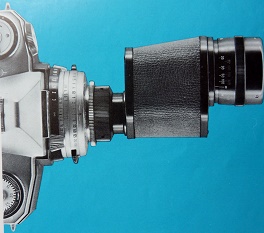
The picture in the “Carl Zeiss Binoculars” catalogue - 1966; in our collection
The lenses are fully coated. The kind of coating suggests it is a later production of this model.
As a telephoto lens at full zoom the lens equivalent is more than 400 mm. The wildlife, nature enthusiasts photographers highly valuated the monocular.
On the cover of the leather case is embossed Zeiss Ikon logo. It suppose the monocular was used as a camera accessory.
The next generation of 8 x 30 B from 1969, is no longer Porro prism, it is Dialyt prism.
Production number - 646303.
|
|
|
|
|
|
|
|
|
|
10 x 80 multicoated cxn (Emil Busch) Flak 45Ëš
Read more on the article
Serial number 112574 |
|
|
|
|
|
|
|
|
|
Carl Zeiss Jena 7 x 50 Septarem H
This model was produced by CZJ in 1936 as the first model with Porro II optic system and with cemented field lenses. It was produced two models of that binocular: Septar with individual focus and the center focus version which was named Septarem. The Septarem was produced for the civilian market.
The binocular was pictured, in 1936 at Olympiad in Berlin, used by Adolf Hitler. On the documentary films it is clearly seen Hitler using this glass.
These models has letter ‘H’ on their description. The letter indicates an increased brightness - ‘H’ is the first letter from - Helligkeit in German language. The later military versions were marked - D.F. 7 x 50 H.
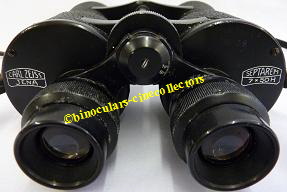
Septarem 7 x 50 H in our collection; © Anna Vacani
It is very hard to find this model in good optical condition. A lot of examples have a chipped prism.
External features:
The binocular body is built from aluminium covered with black textured an early version of vulcanite plastic imitation leather. The engraved description is field with white emulsion. It is visible that the description was repainted.
 the right plate description the right plate description
Our binocular has a specific inscription on the right plate, above word Septarem 7 x50 H. The inscription is - “Like 1900 A NR 38”
The explanation of this inscription, we can find in William Reid book “ Barr & Stroud Binoculars and The Royal Navy”; Published by National Museums of Scotland, Edinburg 2001 (ISBN 1-901663-66-3).
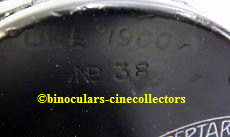 The right plate of the ARL inscription The right plate of the ARL inscription
William Reid explain: “[...] Britain would be at war with Germany again. The quality and the quantity of the binoculars available to the Royal Navy [...] were still causing concern at the Admiralty and elsewhere. A further cycle of tests was launched [...] by C-in-C Home Fleet who insisted early in 1938 that the optic qualities of the Zeiss [...] were dangerously superior to those of the equivalent British glass [...] that would put [...] sailors at fatal disadvantage [...] on the difference in the quality of instruments used by the opposing fleets [...] the Admiralty Research Laboratory [...] was decided to compare [...] Zeiss Binoctar with a Ross Stepnite bought in 1932, [...] a Barr & Stroud CF41/AP1900A. The ARL also bought [...] a Septarem [...] in the market [in 1938]”.
The inscription on our binocular shows the result of the test of the Admiralty Research Laboratory, made in 1938, that this Septarem was the same like Barr & Stroud Patt.1900A.
The original Zeiss production number is not visible.
The eye cups of our binocular have installed the additional rings, vertically knurled.
The binocular dimensions are:
Width (fully extended) over the prism house -160 mm (6,29 in) and underneath of the objectives -188 mm (7,40 in); height - 167 mm (6,57 in) including eye tubes -200 mm (7,87 in) ; weight - 902 gram (1,98 pounds).
The right ocular can be focused. We can adjust the complete sharpness with the wheel mounted under eye bending bars.
The top outside eye lens is made of soft glass and it is very easy to scratch. The outside the objective lens is made from soft glass as well and it gets very often micro scratches. These scratches will cause poor optical performance.
The objective glass unit is not interchangeable with other 7 x 50 Porro I Binoctar & Binoctem as the focal length is different.
Internal features:
Except that the binocular is fitted with cemented Porro II optic system, additionally the “H” letter designation refers to the system of reducing internal light decreased by cementing the filed lens to the prism cluster.
Other information
The Zeiss 7 x 50 Septar H model was bought by Swedish navy in 1936 -1939, ca 1000 binoculars, as we have learnt from Dr Robert Forslund book - “Swedish Military Binoculars; The best Possible Binoculars”. In 1940 further 100 binoculars were bought by Sweden. The binoculars were expensive, but the best in Swedish Admiralty opinion.
|
|
Porro II system - cemented field lens to the prism cluster © Anna Vacani |
|
|
|
|
|
|
|
Page Back (1) (2) (3) (4) (5) (6) (7) (8) (8a) (9)
|
|
|
|